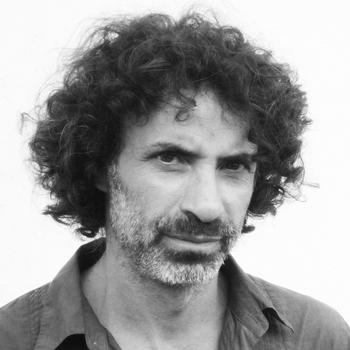Rabih Mroué

Interweaving Performance Cultures
Fellow 2012/13, 2013/14, 2014/15
Rabih Mroué was born in Beirut. He is an actor, director, playwright, visual artist, and a contributing editor of The Drama Review (TDR) and the quarterly Kalamon. He is also a co-founder and a board member of the Beirut Art Centre (BAC), Beirut.
Employing both fictional and true stories as tools for engaging with his immediate reality, Mroué explores the responsibilities of artists to communicate with an audience in given political and cultural contexts. His works include “Riding on a cloud” (2013), “The pixelated revolution” (2012), “Photo-Romance” (2009), “The Inhabitants of images” (2008), “Who’s Afraid of Representation” (2005) and “Looking for a Missing Employee” (2012). He has had solo exhibitions at the Mesnta Gallerija, Ljubljana 2014; SALT, Istanbul 2014; CA2M, Madrid 2013; dOCUMENTA 13, 2012; LundsKonsthall, Lund 2011; and BAK, Utrecht 2010, among others. In 2010, he was awarded an Artist Grant for Theater/Performance Arts from the Foundation of Contemporary Arts 2010, New York. In 2011 he was the recipient of the Spalding Gray Award and the Prince Claus Award.
Research Project
Confrontation between images of the dead and the living
Some years ago, I started writing the story of Deeb Al-Asmar, a Lebanese student who joined the PLO (Palestinian Liberation Organization) in 1969 and was considered the first Lebanese martyr to die for the cause of Palestinian freedom.
However, the story of his martyrdom took an unexpected turn in 1974, when a prisoner exchange took place between Israel and the PLO, and to everyone’s surprise, Deeb Al-Asmar was among the prisoners released by Israel. The Lebanese people were shocked by the news of Deeb being alive. Deeb, in turn, was utterly stupefied by a monument that had been erected in 1971 to commemorate his martyrdom. Amid this perplexity, Deeb found himself the first living martyr in Lebanon.
During my fellowship period, I will continue writing the story of Deeb Al-Asmar, develop its historical background and finally adapt it as a stage performance.
Some of the topics that interest me are the confrontation between images of the dead and the living, the latter’s idolization of martyrdom, the representation of death in war images, the confusion arising from the image of the “first martyr” with Deeb himself after his release.
Recently, many symbols and names – and along with them their monuments – have fallen in the so-called “Arab World” (Saddam Hussein, Gaddafi and others), while new ones are replacing them (El-Sisi, ISIS, Huthis…). The majority of the people there seem to be caught in the toils of confusion, despair and chaos. Still the same question arises, as to why in that “region” images of martyrs are still preferable to images of the living? Where now stands the image of martyrdom, and what happened to the Arab-Israeli struggle?
Recommended Books
- Multiple Authors – Rabih Mroué: A BAK Critical Reader in Artists’ practice – Edited by Maria Hlavajova and Jill Winder, Utrecht/Basis Voor Actuele Kunst and Post Edition, Utrecht, 2012.
- Rabih Mroué, Image(s) Mon Amour – Fabrications - CA2M/ Centro de Arte Dos de Mayo, Madrid, 2014.
- Rabih Mroué, Rabih Mroué, published by Museums and Galleries in Ljubljana/Mestna Gallerija, Ljubljana, 2014.
- Rabih Mroué, Footnotes – a video produced during The International Research Center: “Interweaving Performance Cultures”/Freie Universität – Berlin, 2014 – Library of the IPC Centre.
